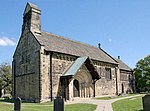Bodington Hall

Bodington Hall was the largest hall of residence of the University of Leeds, in Leeds, England. It was opened in 1961 and closed in 2013. The site still contains the university's main playing fields. Known as Bod within the university, it was located between Lawnswood and Adel, approximately 4 miles north of the main campus. Bodington was used mainly to house first year undergraduate students. Out of term, it was used for conferences and sporting activities such as WorldNET, the Internet Football Association's annual tournament, and from 1994 to 2012 it was the venue for the International Medieval Congress (IMC).The site opened in October 1961, and was completed by 1963. The following year architect Denis Mason-Jones won the Leeds Gold Medal for his design. The hall was named after Sir Nathan Bodington, the first Vice Chancellor of the university. Bodington was originally an all-male hall, with Woodsley, Vaughan, Hay and Seton Houses becoming mixed at the start of the academic year 1976 and the other four following later. For that year the Woodsley student president was Chris Snowden, later Professor Sir Christopher Snowden, vice chancellor of the University of Surrey and subsequently the University of Southampton. A large decorative panel in aluminium by the sculptor Hubert Dalwood was installed on the exterior of the refectory and was Grade II listed in 2012.The self-catering flats were opened in September 1992. The academic year 2011/12 was the last year that students lived a full year in the halls although a smaller group of students, including late accommodation applications and students from Clearing, were allowed to stay in the halls for the first term of 2012/13. Bodington Hall was officially closed in January 2013, and demolished to enable housing to be built on the site.
Excerpt from the Wikipedia article Bodington Hall (License: CC BY-SA 3.0, Authors, Images).Bodington Hall
Leeds Adel
Geographical coordinates (GPS) Address Nearby Places Show on map
Geographical coordinates (GPS)
| Latitude | Longitude |
|---|---|
| N 53.8444 ° | E -1.5876 ° |
Address
LS16 8FW Leeds, Adel
England, United Kingdom
Open on Google Maps









